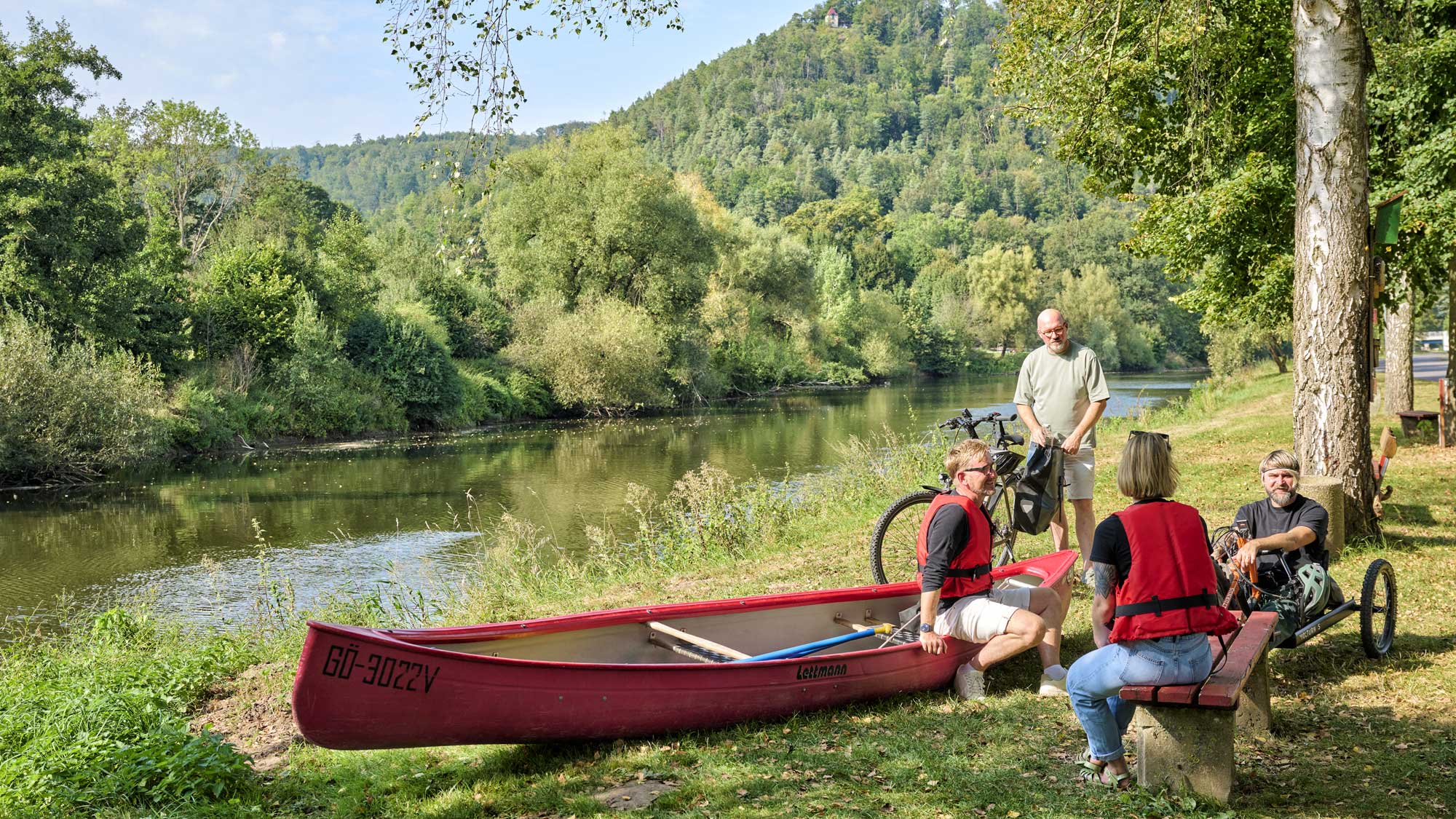You're in the right place! Whether in nature, in the middle of the city, for families, in the countryside, historic or traditional: among Thuringia's TOP hosts, everyone will find exactly the right address.
Damp but delightful hiking fun
Gorge tour
Before Margit Stephan sets off with a group, she wants to know a few things. Would they like to hike for an hour or two, or half a day? Would they prefer to go uphill first, or downhill? Is there anyone with a pram or buggy? Because, like bikes, they're not permitted in the Drachenschlucht gorge. It doesn't take a lot of imagination to understand why, once you're standing at the ravine's the tightest spot. Incidentally: the gorge tour starts at the car park "Wanderparkplatz Phantasie", which is located on the southern edge of Eisenach and can also easily be reached by bus. Bye-bye, period properties and hello, nature! We are following the stream, which winds its way charmingly through a small spinney and water meadows, until we reach the Königskreuzung, König's crossing. How did it get its name? The visitor guide and nature tour leader from Eisenach's visitor guide and tour leaders' association points out a large memorial stone erected in honour of a man called Gottlob König on a nearby hilltop. "He is generally considered to have been one of the most important forestry and forest science figures of the 19th century who, in keeping with his motto 'the forests are our country's brightest jewels', did much for the great outdoors," says the 57-year-old. One of his achievements was to make the Drachenschlucht gorge, which had long been thought to be impassable, accessible to the public. However, more about this later.
After all, we are intending to hike the longer tour, so we don't turn right in Mariental valley, but left towards the no less interesting Landgrafenschlucht gorge, which is associated with the following story: "Frederick I, Margrave of Meissen, a.k.a. as Frederick the Bitten – allegedly, it was his mother who did the biting! – is said to have hidden here with his men in order to conquer nearby Wartburg Castle, or rather, to claim the inheritance he believed to be his due." Whilst Margit Stephan, who also works as a historic city tour guide, tells this and other stories, we are walking past beech and hornbeam, maple and linden trees. Some have fallen over and now lie across the gurgling stream like natural works of art. A pretty path with quite a few soggy patches runs along its banks. A few streamlets hurrying down the slopes, which are gradually becoming steeper, continuously feed the stream with more water and ensure that there is no lack of mossy areas. "In summer, it's pleasantly cool in the gorges," says Stephan, "although each season has its own charms." Many are captivated by these charms, from lone hikers to families and groups. "17,000 people took part in the last Easter hike to the gorges organised by local TV channel MDR," says Stephan, "and even twice as many came on national hiking day in 2017!"
Germany's most famous castle and busiest hiking trail
Wide-eyed wonder. However, there's no reason to panic: "Don't worry about overcrowding; they're usually well spread out along the trail." After all, the region offers hundreds of kilometres of tempting hiking trails, with the legendary Rennsteig trail the most popular. We reach this trail after a longer uphill climb. Although, strictly speaking, we first follow the historic coach road for a little while, the "mediaeval motorway". Today, we have the "Marienblick" viewpoint, which affords views of Wartburg Castle, Germany's most famous thanks to Luther's Bible translation and other major events, all to ourselves. Looking in the other directions is also rewarding. Blueish woad and white wood anemones can be spotted on the forest floor; towards the east, you can see the Hörselberge hills, which play a role in Wagner's opera Tannhäuser. Stephan's tip: the views from the top of the Großer Drachenstein are even more majestic; it's only a few more minutes' uphill climb...
Following the coach road southwards, we are soon clearly on the Rennsteig trail. It is signposted on the B19, which we have to cross; there are also signs informing us of the planned construction of a four-star spa hotel next to the "Hohe Sonne" ('High Sun'). So what's the story behind the name of this former hunting lodge that was an iconic restaurant for many years? It was inspired by the iron sun emblem underneath which we are now eating the sandwiches we have brought with us at one of the picnic tables. A good opportunity to talk about Germany's busiest long distance hiking trail, which was created when the country was still divided. After its reunification in the 1990s, it was extended by several kilometres that formerly belonged to the exclusion zone at the border between East and West Germany. Now, the traditional starting point is (again) Hörschel by the Werra river.
Encroaching cliffs, fallen giant trees
However, we turn off the trail before this, downhill towards the Drachenschlucht, the dragon gorge. In the olden days, people believed that it was a lindwurm's lair. The furore surrounding the dragon slayer George, who is the patron saint of the city of Eisenach, after all, did the rest. Also, from a marketing perspective, the name as such already makes it irresistibly attractive to children who are fans of a certain series of fantasy books – as many parents probably know only too well.
However, let's get down to the facts: Across its length of 2.6 kilometres, the ravine climbs up almost 200 metres. In the middle area, again for around 200 metres, the sheer rock faces on either side are only 68 centimetres apart. Woe all those who have drunk too much of the local beer and eaten too many Thuringian dumplings or Bratwurst sausages! Now, at the latest, the fact that prams or buggies are not allowed on the trail makes total sense...
What is not quite clear yet: Why are there so many gorges in this one particular area? We read the answer on an information board: "Around 280 million years ago, weathering detritus from the Thuringian mountains solidified in the Eisenach trough and formed the layer of Rotliegend that can be seen here, a resilient conglomerate. Over the following millions of years, flowing water eroded debris and the surface material and carried it towards the valleys." Right, so this is how the deep gorges and steep cliffs of the region were formed.
A geological treasure such as this one must be protected; hence the designation as a nature conservation area that was not extended to almost 800 hectares until 2015, which is also good news for the local flora and fauna. Giant trees that have tumbled are therefore allowed to remain where they have fallen, which contributes to the mystical look of the landscape. Ferns and imposing mushroom colonies settle on them, and they also provide homes for the numerous woodpecker varieties and bats that can be found here. Which brings us back to the subject of lindwurms once more. "Even a few descendants of dragons live here: fire salamanders and the rare crested newt," says Stephan with a grin.
Verdant wherever you look
After running over wooden planks, the path increasingly leads across plastic grids made from recycled GRP – and directly over the stream. Exciting! It gurgles impressively loud, amplified by the worryingly close rock faces. Dolby surround sound! Pleasant side effect: The gurgling drowns out the noise from the nearby major road, although you can't actually see it from here. Instead, there are mosses, ferns and greenery in all shades, and you can hear drips and trickles all over the place. Now, you understand what Stephan said earlier on: "You always get dirty on the gorge tour – and you'll definitely get wet shoes." Less so on the inside, but certainly on the outside. White trainers or heeled shoes? Really not a good idea. Anyone wearing a pair of ordinary hiking shoes with a bit of stamina, however, can easily manage the almost twelve kilometres of the tour, which takes three to four hours.
Even more tours
Header Picture: ©Dominik Ketz, Regionalverbund Thüringer Wald e.V.
Accessibility
Did you like this story?
You might also be interested in ...














